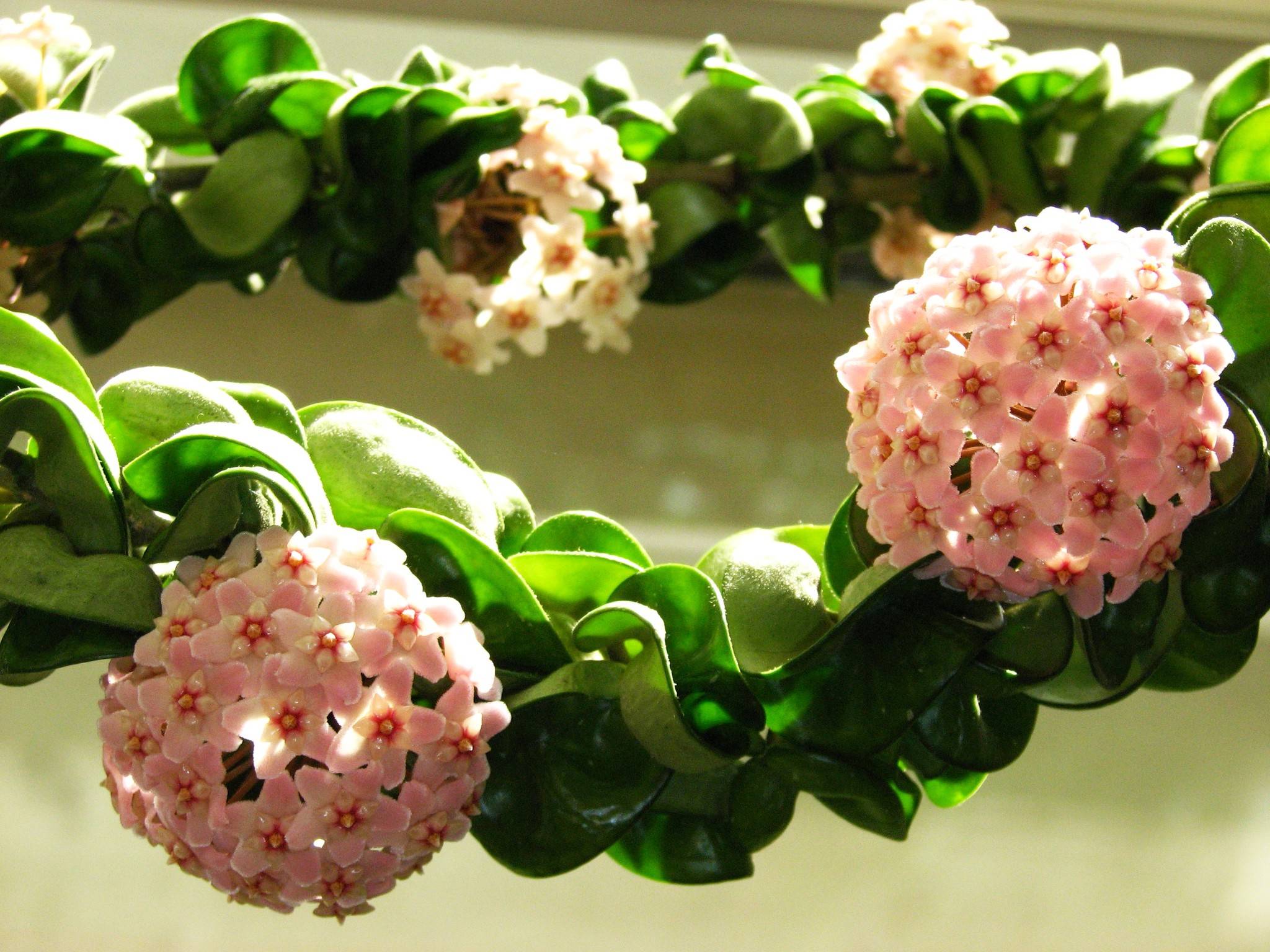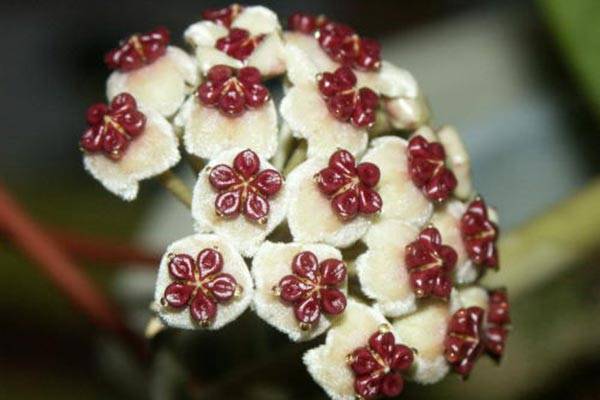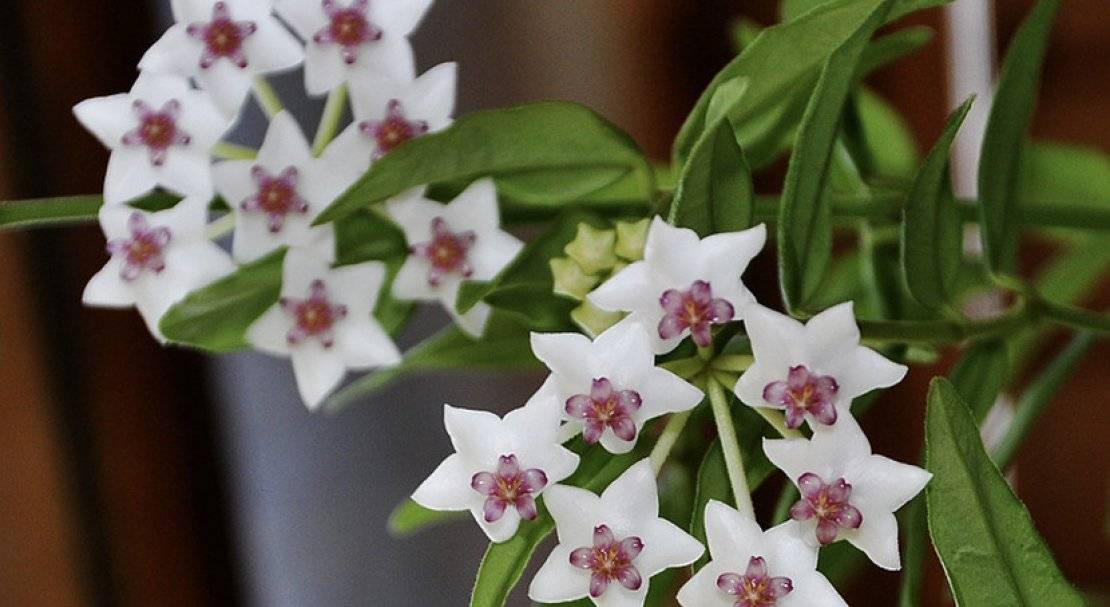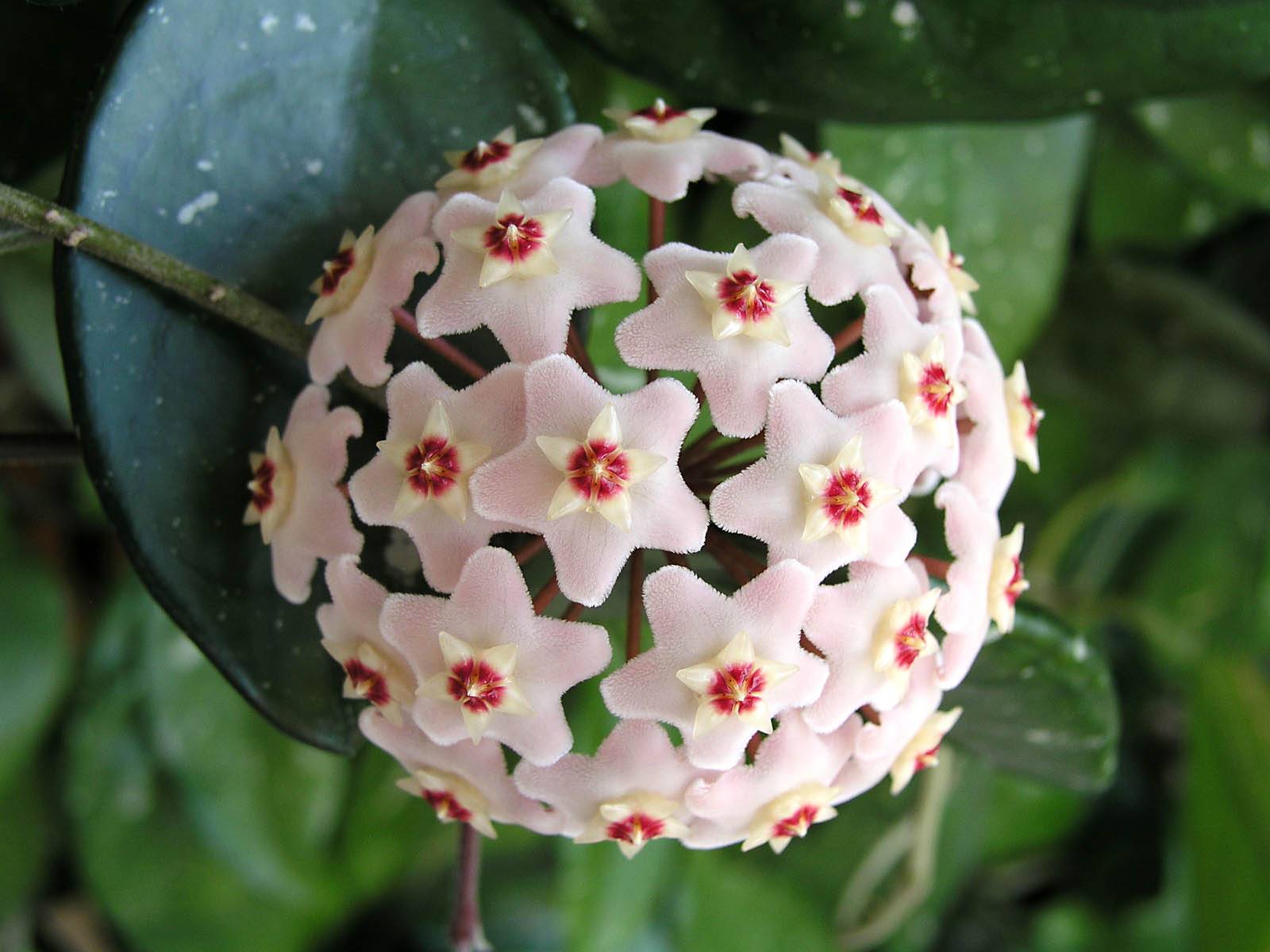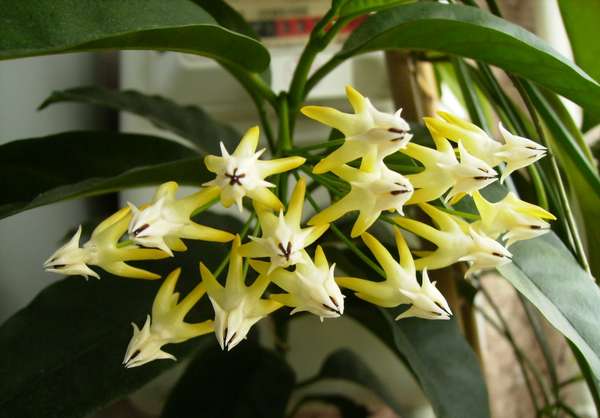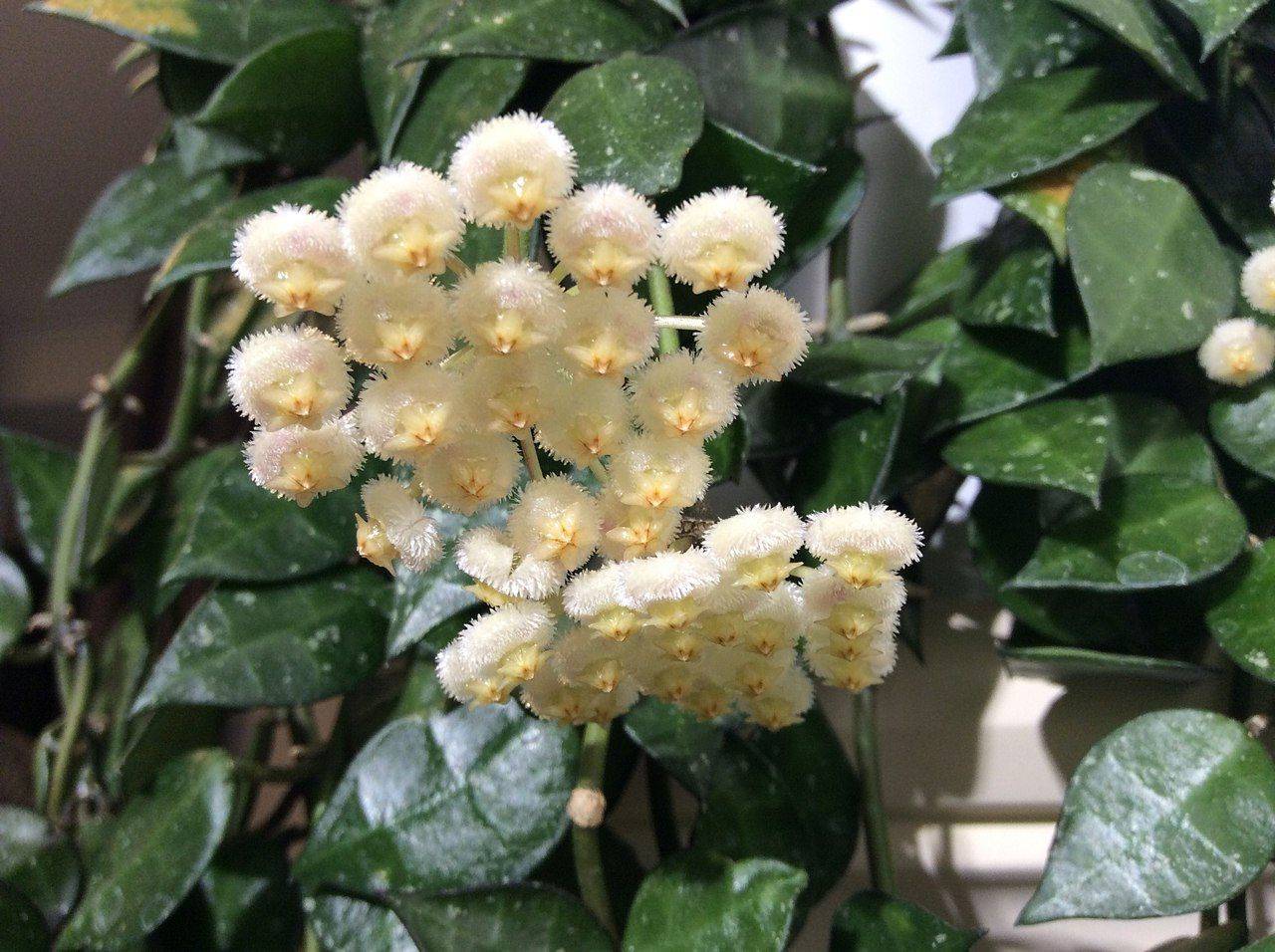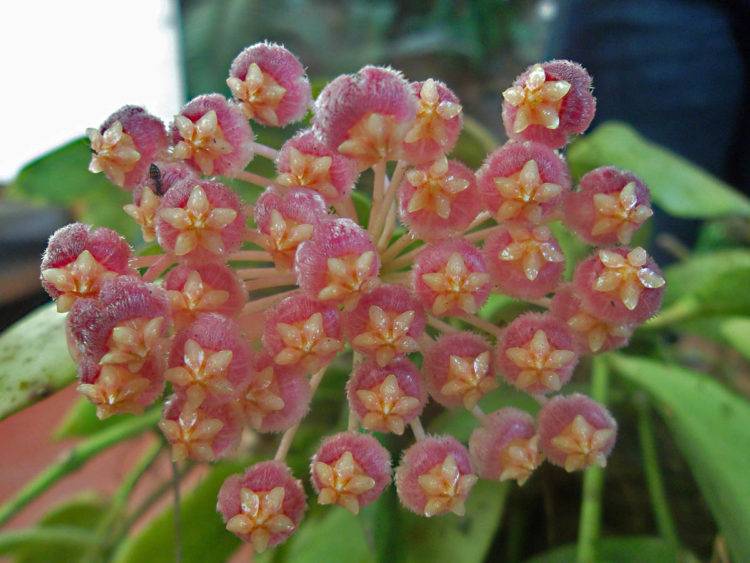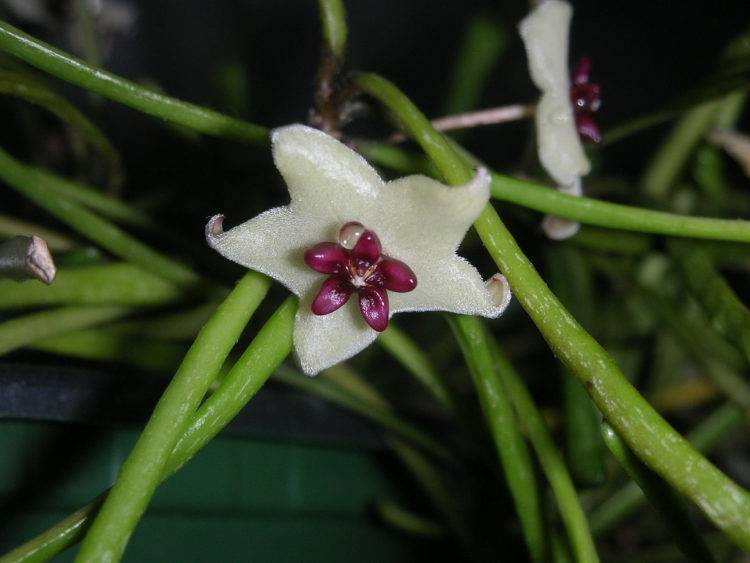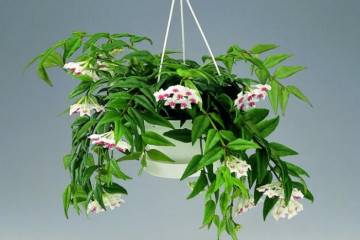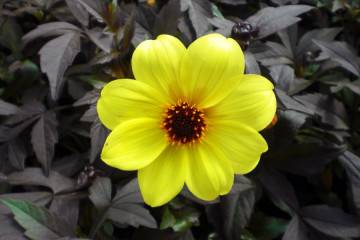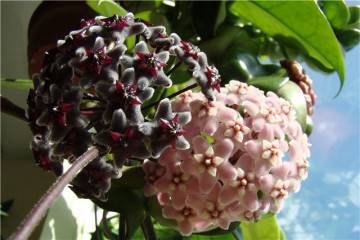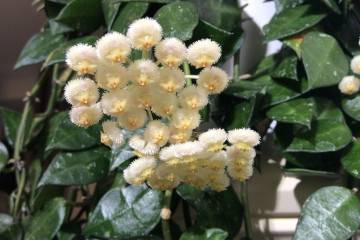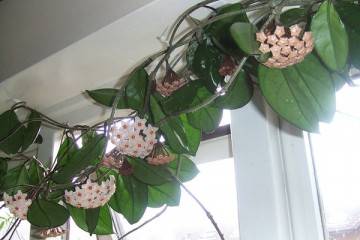Hoya flower - what the varieties of Karnosa, Kerry, Bella, fleshy, Multiflora look like
Content:
Wax ivy, or hoya, is a shrub from the Kutrovy family. It is an evergreen liana with more than two hundred species. It grows mainly in the tropical forests of Asia, Polynesia and in the western part off the coast of Australia. The plant loves rare forests, choosing a tree for itself, using it as a support. Can grow on rocky slopes instead of trees.
The name of the plant was given by the scientist Brown in honor of a friend and gardener from England T. Hoy. It was the gardener who was engaged in the cultivation of various tropical plants in the duke's greenhouses and devoted his whole life to this.
Hoya flower - what is this plant
Depending on the type, the vine can be creeping, hanging or curly. Some members of the hoya have specific antennae that allow them to cling to the chosen support.
The leaves of the plant are large oval. May be heart-shaped. Typically, most species have dark green leaves. But there are species with tricolor leaves, decorated with specks or specks. For example, a type of hoya called compact (compact hoya) has curled leaves.
Almost all types of hoya have leaves with a glossy surface. They may appear to be waxed, which is why the plant is called wax ivy. The flowers of this plant are very diverse, quite graceful. They can be pink, white, yellow in the form of stars.
How it blooms
Grown plants, with properly organized care and good daylight hours, bloom abundantly at home and for a long time. In order for the hoya to bloom and feel good in the apartment, it is necessary to place a pot with a plant on the west or east window. This vine grows well on southern windows in winter. In the summer heat, under the scorching rays of the sun, the leaves of the creeper can dry out, and the growth of the plant will slow down as a result of overheating.
Wax ivy inflorescences can be white or pink, sometimes they are yellow stars. They are collected in umbrellas and are located on the core processes. The flowers are up to 2 cm in diameter. Some species, for example, the imperial hoya, can have flowers up to 8 cm in diameter. The center of each corolla is decorated with a five-membered crown that rises above the petals themselves.
Note! All hoyis have fragrant flowers and secrete nectar to attract insects.
Home or indoor hoyis fall into several categories:
- ampelous - hanging;
- erect - look like a small bush;
- ivy - wrap around the support.
Hoya care rules at home
Each hoya, depending on the species, requires its own conditions for keeping. Common to all types of wax ivy is the control of soil moisture. The formation of dirt in the pot has a detrimental effect on any hoya, even the most unpretentious one.
Florists conditionally divide hoyi into categories according to moisture consumption and need for light:
- hoya with hard leaves, like succulents - fleshy and hoya kerry.A great location for these flowers is a south window, where there is plenty of sunlight. Watering is done as the soil dries up;
- plant varieties with thin leaves (for example, multiflorous hoya) love moist soil and cannot stand direct sunlight. They need shading and location on the west or east window;
- hoya with pubescent leaves of a light green color (linear hoya, de Serain, etc.), grow well in moist soil with a sufficient amount of sunlight;
- hoya with pubescent leaves of a dark green color (serpentine and Thompson's hoya), prefer shaded areas of the windowsill and require regular watering.
Plants growing at home do not fall into a pronounced dormant period. You can notice that the plant is in a semi-dormant state by slowing down its growth. During this period, it is recommended to abandon feeding and reduce the number of waterings. The plant should rest. The period of incomplete rest occurs in indoor flowers with a decrease in daylight hours. Turning on the lighting in the evening, respectively, prolonging the daylight hours will shorten the dormant period.
Fertilization and plant transplant
In nature, there are about two hundred species. They all require different types of fertilizers, as they grow in different regions in the wild. Experienced growers have found that succulent fertilizer is the best fertilizer for all types of wax ivy. Hoyis also respond well when they are regularly transplanted into fresh soil. At the same time, fertilizing is not applied so often.
Young plants are recommended to be replanted every year in the spring. The grown-ups require a transplant once every 2-3 years, if necessary. Hoyi do not require large pots to grow. But it is important to remember that with each transplant, the plant needs a new container, and not after other flowers.
The selected soil mixture for indoor liana must be sterilized. Choose a mixture for transplanting with good air permeability, having a neutral or slightly acidic pH.
Excellent composition - humus, leafy earth in equal parts and twice as much clay-sod soil. Some varieties thrive in orchid substrates.
Drainage is laid at the bottom of the pot, and the transplant is carried out by the transshipment method (without destroying the earthen coma).
Pests and diseases
In the wild, wax ivy is highly resistant to various pests and diseases. But at home, with poor care, the hoya can be affected by a scabbard, aphids or a spider mite. For pest control, special insecticides are used.
Prevention of nematode development in a plant pot is achieved by sterilizing the soil before transplanting.
Popular varieties
The following varieties are in great demand among florists.
Kerry
Hoya Kerry, or Valentine (hoya in love), got its name from the shape of the leaf, resembling a heart. To prevent ampelous plant species from overturning, the stems must be constantly tied up. The length of hard leaves can reach about 15 cm.
Kerry flowers are pubescent and collected in globular umbrellas. The color directly depends on the amount of light in the room where the plant grows. The hue of the flower changes as soon as the amount of light changes.
Bella
Bella is a real shrub with hanging shoots with small ovoid leaves. The flowers are perfect and seem like a real work of art. White stars with a purple crown are gathered in small umbrellas. Hoya Bella leaves can be green or variegated, depending on the variety.
Fleshy
Fleshy hoya, or Karnosa hoya is a climbing evergreen plant that can reach a height of 6 m, therefore, when grown, it requires support. Her flowers are fragrant, painted white and have a pink crown in the very center. Leaves are oval, small, covered with a bloom in the form of wax.
Hoya fleshy is the most popular vine among lovers of exotic house plants. There are several varieties - Krimson Queen, Tricolor, Compact.
Multiflora
Hoya Multiflora is a species that winds. The leaves are oblong. Inflorescences of Multiflora are yellow. Feature during flowering - the petals have arcuate spurs.
Matilda
An attractive type of wax ivy - Matilda. It differs from its relatives in its small size. Variegated leaves with small specks. Hoya Matilda blooms in white with a greenish tint. The core of the flower is red. In a diameter they are up to 2 cm. It emits nectar well and loves a lot of sunlight. In order for the plant to always delight with its flowers, it is necessary to provide additional lighting. In winter, daylight hours should be about 14-15 hours.
Lacunose
Hoya type with diamond-shaped leaves painted in dark green. They have a glossy sheen. The leaf plate of the hoya Lacunose has small whitish-silvery lines. The flowers are white with yellow in the middle. In the process of flowering, it exudes a delicate aroma. Lacunose smells like an elegant women's perfume.
Vayeti
Elegance and tenderness are all about Hoya Vayeti. It is native to the Philippines, but the vine grows well at home in hanging pots. An ampel plant with long lashes, sometimes reaching more than 10 m in length, must be regularly pinched. The wriggling stems form air roots. The flowering period is long. It is not advisable to move the pot with the plant from one place to another during this period, since it can react by dropping the peduncles.
Locke
Hoya Locky is an overseas beauty named after a botanist from Vietnam. It bears a great resemblance to its relative Hoya Multiflora, but at the same time it is much more elegant. Blooms constantly and profusely in white. The blossoming flowers exude a caramel aroma. Some growers compare the aroma of Hoya Loki with the scent of chocolate.
Gracilis
Philippine princess or beauty from Sulawesi - Hoya Gracilis. A plant with pubescent leaves. An unusual-looking hoya has nodules on the stem, from which several leaves appear at once, creating a kind of rug. When sunlight hits the leaves, the leaves begin to turn pink. The resulting stains become very contrasting.
Obovata
Obovata is a hoya from the tropics. In the wild, it grows in areas of Indonesia, Thailand and India. Prefers wet regions. The discovery of this species took place at the end of the 19th century, and only at the beginning of the 20th century. the plant was brought to the territory of Europe, therefore it has been little studied.
Obscura
The aroma in the process of flowering at Hoya Obscura is unusually pleasant, reminiscent of the smell of vanilla. Similar in smell to the scent of flowering lilies. This type of wax ivy has no more than 2-3 leaves on the shoots. Together, they create a carpet effect.The peduncle produces 20 to 25 small flowers that resemble stars.
The leaf of the hoya Obscura is narrow, slightly compressed from the sides. In this regard, this type of hoya has a name - compressed. It was discovered in the wild back in the 18th century, but it was bred into a separate species much later.
Hoya Retuza
Rare plant - Retuza. It is so unusual and beautiful that it is the dream of many flower growers. The ampelous hoya has thin shoots of a green hue with crimson colors. Over time, as the plants grow older, the blotches become gray in color.
In the wild, it grows in Indonesia and India. The leaves of this species are thin and long with an unusual color. Flowers reach 1.5 cm in diameter, gathering in an umbrella.
Pubicalix
Hoya Pubicalix is a tropical variety of evergreen wax ivy. It grows in the wild on the coasts of Australia, India and parts of southern Asia. Hoya Pubicalix is unpretentious in care and pleases with long flowering.
Undulata
The homeland of Hoya Undulata is the Indonesian peninsula and Kalimantan. This species grows at an altitude of over 350 m above sea level. The leaf edge of this variety is wavy, due to which it received its second name, wavy hoya.
Among the variety of hoya species, plant breeders will surely find something unusual for themselves. All hoyis are unpretentious, but they should create conditions that are inherent for their natural growth. Being tropical representatives, these vines prefer a humid climate. It is important to remember that during the appearance of the peduncle it is not recommended to touch the plant in order to avoid dropping flowers.


